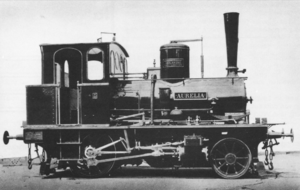Badische I d
| Badische I d | |
|---|---|
|
No. 62 AURELIA
|
|
| Numbering: | 62, 436, 437 |
| Manufacturer: | Mechanical Engineering Society Karlsruhe |
| Year of construction (s): | 1882, 1885 |
| Retirement: | 1916 |
| Type : | 1A n2t |
| Gauge : | 1435 mm ( standard gauge ) |
| Length over buffers: | 7190 mm |
| Total wheelbase: | 3500 mm |
| Empty mass: | 18.45 t |
| Service mass: | 23.40 t |
| Friction mass: | 11.80 t |
| Wheel set mass : | 11.80 t |
| Top speed: | 60 km / h |
| Driving wheel diameter: | 1240 mm |
| Impeller diameter: | 965 mm |
| Control type : | Stephenson |
| Cylinder diameter: | 260 mm |
| Piston stroke: | 450 mm |
| Boiler overpressure: | 9 bar |
| Number of heating pipes: | 112 |
| Heating pipe length: | 2200 mm |
| Grate area: | 0.75 m² |
| Radiant heating surface: | 4.50 m² |
| Tubular heating surface: | 27.80 m² |
| Evaporation heating surface: | 32.30 m² |
| Water supply: | 2.00 m³ |
| Fuel supply: | 0.90 t of coal |
| Brake: | Westinghouse air brake |
The vehicles of type I d of the Grand Ducal Baden State Railroad were small two-axle tank locomotives with one driven axle . The locomotives were also referred to as " omnibus locomotives".
history
In 1882 the Grand Ducal Baden State Railroad procured a small tank locomotive. Two more tank locomotives were procured in 1885 for use on the 2.27 kilometer long Ettlinger Seitenbahn between the Ettlingen West and Ettlingen Stadt stations . Similar locomotives were also in use in Oldenburg at the time. The aim of the construction was to transport passenger trains with one to three cars . The two locomotives built in 1885 were only used on the side line until 1887, the older locomotive from around 1890 to 1896. After BLEAG took over management of the side line , the locomotives were used elsewhere. No. 62 came to the Constance depot in 1898 and stayed there until it was retired in 1917. The other two locomotives changed locations more often, except in Karlsruhe they were also used in Offenburg, Freiburg, Basel, Haltingen, Mannheim and Konstanz.
The locomotives were taken out of service around 1917/1918.
Constructive features
The locomotives had a sheet metal frame with cutouts. The water tank was hung in the frame . The long shell of the vehicles was two-shot. The steam dome sat in the middle of the kettle . The regulator was located immediately behind it. The regulator train ran along the top of the boiler. The external inlet pipes were level with the rear boiler section. The conical chimney was made relatively long.
The two-cylinder wet steam - engine was arranged on the outside horizontally. The cylinder block was immediately behind the barrel axis . The construction required long connecting rods . The cross head was guided by a rail. The Stephenson control was external.
The drive axle was cushioned by leaf springs below the axle box. In the case of the running axle, the leaf springs were above the axle bearing above the running plate.
A screw brake acted on the drive axle from behind. A Westinghouse air brake installed later acted on the drive axle from both sides.
The cab was spacious. The sandpit was originally located in the driver's cab above the driving axis. Later the box was moved to the standing kettle.
The coal container was on the rear wall of the cab. The water filler neck was on the right side of the long boiler.
literature
- Hermann Lohr, Georg Thielmann: Baden locomotive archive . transpress, Berlin 1988, ISBN 3-344-00210-4 .
- Iffländer, Helmut., Bavarian Railway Museum (Nördlingen): The Alb Valley Railway : from the little train to the modern local transport company . Braun, Munich 1987, ISBN 3-925120-03-3 , pp. 27-30 .
